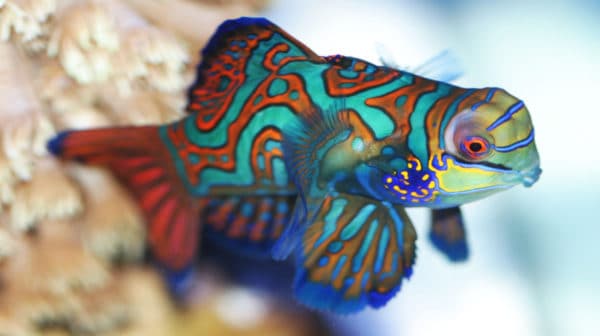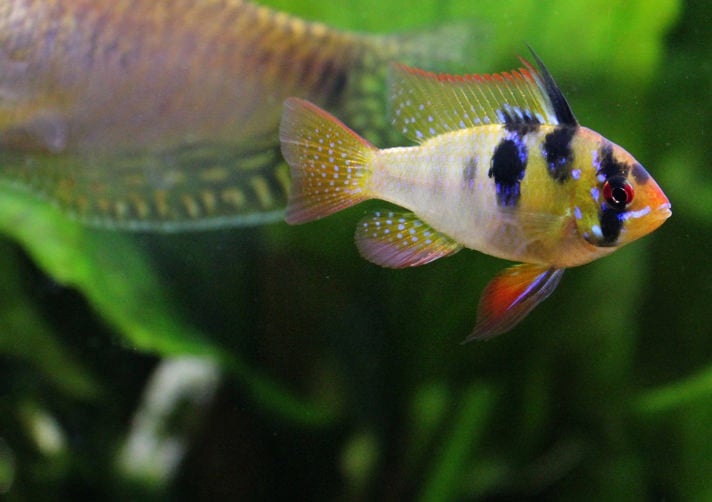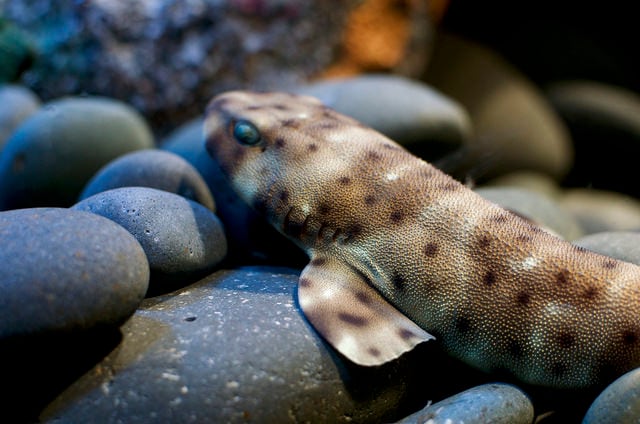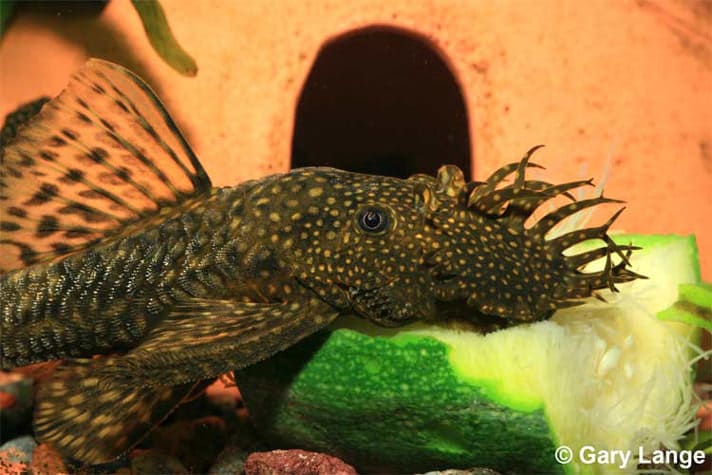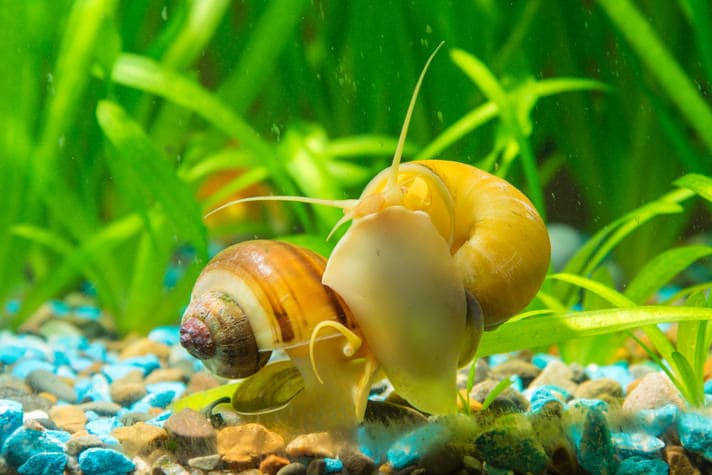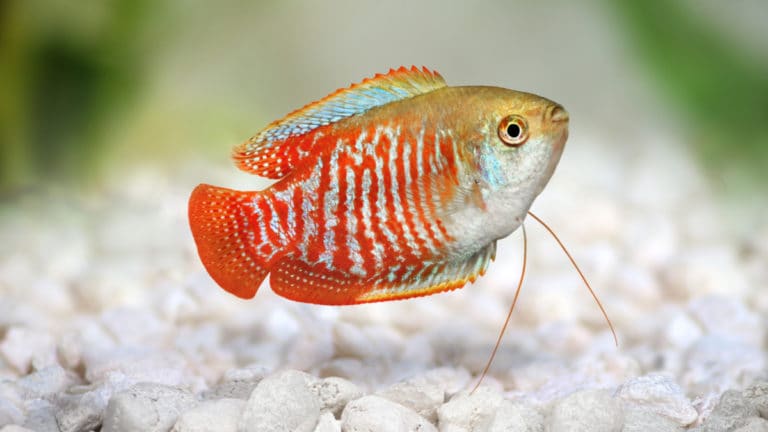Where our fish come from, and how they were obtained, is important information to consider when stocking a system. We have three main options: wild-caught, tank-raised, or captive bred. Wild-caught obviously refers to animals that have been captured in the wild and brought into captivity, but the other two terms are not necessarily clear cut. Tank raised means that eggs or larvae have been collected from the wild and raised in captivity, while captive/tank-bred refers to animals that have been reared from egg to adult in a captive environment.
Many species are not currently available by any means other than wild collection, and I feel sustainable harvesting can have a positive impact on indigenous people, who make a living capturing aquarium animals while being given a strong reason to protect that environment for the future.
Sustainable wild collection for the aquarium trade has the potential to protect our world’s coral reef ecosystems by showing coastal people the true value of their natural resources so they understand the importance of keeping these underwater habitats healthy. If the reefs are healthy, there will be many fish to collect and plenty of work, both for the current generations and those to come. While there are valid reasons for some aquarists, particularly those who have many years of experience or are breeders, to choose a wild-caught animal over a captive-bred one, for the vast majority of us, tank-raised and captive-bred specimens should be our preferred options. These animals are perfectly adapted to aquarium life, used to eating commercial foods and unlikely to harbor disease. They also reduce stress on ecosystems from collection pressure by eliminating the need for all ornamentals to be wild-caught, and they are often considered to be the best livestock available.
The number of captive-bred marine ornamental species that aquarists now have access to is constantly growing and not in any small part due to the efforts of dedicated hobbyists as well as nonprofit organizations—such as Marine Breeders Initiative, a breeder’s award program that supports and promotes the captive breeding of marine organisms—and companies, such as Oceans, Reefs, and Aquariums (ORA) and Sustainable Aquatics (SA), which supply our trade with 100 percent, captive-bred fish and aquacultured corals.
According to a 2014 list of captive-bred marine fish, approximately 250 species of ornamentals have now been tank-bred, ranging from anemonefish to gobies to seahorses. This certainly does not mean that we regularly have access to every species that has been bred thus far, but the more we support these efforts with our wallets, the better chance we will have of one day being able to choose from hundreds of readily available tank-bred marine fish without feeling limited to a tank full of clownfish. This article is meant to be a top 10 list of captive-bred marine ornamentals currently available, accompanied by information about their life history, care requirements and their respective places in the world of tank-bred fish. I will, of course, have to begin with the most well-known of all captive-bred fish: Amphiprion ocellaris.
1. Ocellaris clownfish, common clownfish, false percula anemonefish (Amphiprion ocellaris)
When we hear the word “clownfish” in any context, it’s the image of this fish (below) that comes to mind 99.9 percent of the time. Martin Moe, the father of commercial marine ornamental aquaculture, was the first person to reliably breed these captivating fish in 1972. This is both the most popular clownfish—and fish overall—in the world of CB marine organisms, and it will likely remain a staple in the trade, as it is the poster fish for the marine aquarium hobby. Wild-type coloration is still the norm, but the appearance of new designer varieties is changing our idea of what a normal ocellaris looks like. Snowflake and Black Ice and DaVinci color morphs are now all popular terms in the trade, and they refer to an ever-expanding range of clownfish that still fall into the ocellaris category but seem to look less like the species holotype with every new iteration.
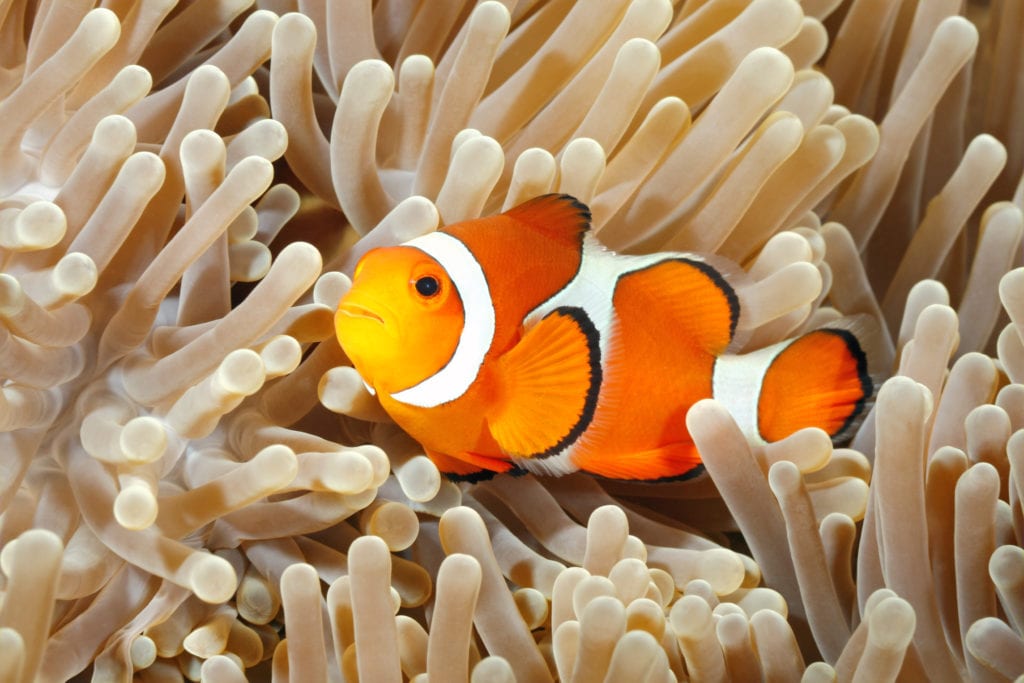
Photo: cbpix/Shutterstock
Regardless of their particular designer designation, their demeanor and care requirements are the same. Clownfish, in general, are ideal fish for aquariums because, even in the wild, they live within tiny territories and rarely venture more than a few feet from their host anemone. Ocellaris clowns epitomize this idea of the perfect aquarium fish in that they stay small (less than 4 inches), occupy a particularly small territory and are typically mild-mannered, personable and nonaggressive. They will defend themselves, but they certainly don’t instigate fights as do many other clowns. They can be successfully maintained and bred in fish aquariums of 10 gallons or more, get along with most tank mates and, while they don’t require anemones for survival, seem to be more content when one is present. In the wild, ocellaris clowns live in the east Indo-Asian Pacific waters, from the Andaman Sea to northwest Australia, central Indonesia and the Philippines.
They host in four anemone species—magnificent/ritteri (Heteractis magnifica), giant carpet (Stichodactyla gigantea), Haddon’s/saddle carpet (S. haddoni) and Merten’s carpet (S. mertensii)—but can be persuaded with little coaxing to inhabit a bubble tip (Entacmaea quadricolor) in captivity. They adapt easily to most prepared foods, both dry and frozen, but do best when fed a varied fish food diet of meaty foods supplemented with raw seaweed.
There are 30 described species of anemonefish, all of which belong to the genus Amphiprion, with the exception of one species, the maroon clownfish or spinecheek anemonefish (Premnas biaculeatus), which I will discuss later. Ocellaris clowns are often confused with their close relatives, A. percula, which have a strikingly similar appearance and parallel mannerisms. They all belong to the damselfish family, Pomacentridae, and exhibit sexual dimorphism and sequential hermaphroditism, respectively meaning that males and females differ notably in appearance and are capable of changing gender. Females are always larger than males and are decidedly more aggressive. Clownfish all begin life as sexually immature males, but eventually, they move up the ranks of their matriarchal social hierarchy to first become mature males and then potentially breeding females. This reproductive adaptation ensures that if a breeding female is suddenly lost, her role will soon be filled by her mate as he changes gender. This gender transformation can only occur in one direction, and once a male has become female, he will remain as such indefinitely.
- Temp: 72 to 78 degrees Fahrenheit
- pH: 8 to 8.4
- Water Hardness: dKH 8 to 12
- Size: 3 to 4 inches
- Food: Varied diet of meaty foods supplemented with raw seaweed
- Orientation: Wherever they decide “home” is. Typically, clownfish inhabit the bottom third of their tanks, especially if an anemone is present, but many of us have likely kept clowns that settle onto the power head or near an overflow box and seem to be quite content there, too.
2. Neon Goby (Elacatinus oceanops)
Like ocellaris clownfish, this tiny cleaner goby was first propagated on a commercial scale by Martin Moe in the early 1970s. They are now one of the most recognizable marine aquarium fish and extremely useful additions to reef tanks; they eat parasites and keep larger tank inhabitants healthier. They are often still unofficially referred to as Gobiosoma oceanops, a taxonomic classification that is not necessarily incorrect but considered less appropriate since the type specimen for the neon goby was named E. oceanops by D.S. Jordan in 1904. These gobies stay small (about 2 inches), are extremely docile and can coexist with nearly all fish species due to their recognized role as parasite pickers. They generally show aggression only toward members of their own species, and much of this combativeness can be avoided by keeping only a mated pair or a larger group of six or more neon gobies in an aquarium at once. 
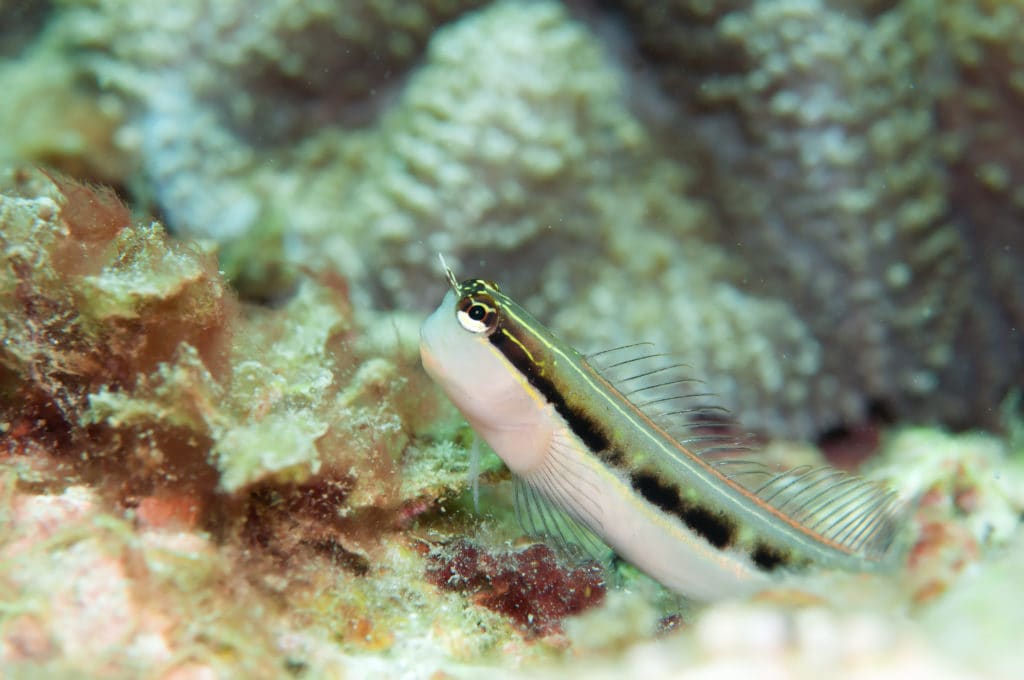
Photo: Jung Hsuan/Shutterstock
They have gained popularity within the nano- and pico-reef community, because they are one of few readily available species that can comfortably live in such small systems. While they subsist almost entirely on parasites they eat off the skin, mouth and gills of larger fish in their natural habitat in Florida and parts of the Caribbean, they accept small bits of frozen and dry foods in captivity.
MORE:
Despite their short lifespan of 1 to 2 years, they are incredibly prolific. A single female is capable of producing upward of 500 eggs during each spawning event, but more typical spawns yield around 250 eggs. These gobies form monogamous pairs, where the male is the primary caretaker of their demersal eggs until they hatch, after which point all parental care ends. The fact that they spawn on stationary surfaces (demersal), just like clownfish do, as opposed to mid-water like tangs (pelagic), makes them ideal candidates for captive breeding; this aspect of their natural history makes egg collection fairly simple. They often spawn in crevices or on overturned shells. The male guards and fans the eggs to ensure proper oxygenation, and the female patrols the area for intruders.
These beautiful little fish are black with bright blue stripes and are one of many species of Elacatinus that have been successfully reared in captivity. These are great animals for practically any size tank, and they are compatible with the species composition of nearly every community aquarium, with the exception of being vulnerable to predation by ambush feeders, such as mantis shrimp and pistol shrimp.
- Temp: 72 to 78 degrees
- pH: 8 to 8.4
- Water Hardness: dKH 8 to 12
- Size: 1.5 to 2 inches
- Food: Tiny bits of meaty foods (live Artemia nauplii will make them as happy as one can ever expect to see a goby.)
- Orientation: Bottom and middle
3. Banggai cardinalfish, longfin cardinalfish, Kaudern’s cardinal (Pterapogon kauderni)
There has been much controversy surrounding this fish as of late and for good reason. The Banggai cardinalfish is currently being driven to the brink of extinction by rampant over-collecting for the aquarium trade in its native habitat of Indonesia’s Banggai Islands, and this is the precise reason that it’s a perfect candidate for captive breeding. Although Banggai cardinals are listed as “endangered” on the International Union for Conservation of Nature Red List, they are still being imported at an alarming rate that must be slowed before this unique, endemic species is extirpated from its home waters in Sulawesi.
They are notoriously poor travelers, and large percentages of them succumb to illness shortly after transport from a combination of shipping stress and a suspected species-specific virus that strikes after import. Banggai cardinalfish iridovirus (BCIV) is currently restricted to wild-caught specimens and has a 100 percent mortality rate. Symptoms include suppressed appetite, lethargy, loss of balance, a sunken gut and a darkening of their overall pigmentation preceding death.

Photo: Vladimir Wrangel/Shutterstock
Recent advances have been made in our understanding of the natural history and reproduction of this species as well as the diseases and collection pressures that threaten its long-term survival in the wild and in captivity. Much of this important information was obtained through the Banggai Rescue Project, a research expedition to the Banggai Islands conducted by a team of marine biologists and ecologists, culminating in the publication of Banggai Rescue, a book that is being touted as “the new bible for every Banggai cardinalfish enthusiast and breeder.” Research projects like this one—collectively funded and supported by hobbyists, industry professionals and scientists—provide us with invaluable lessons about the animals we keep and the threats they face in their native waters while giving us an opportunity to support the sustainable production of one of our hobby’s most iconic marine species.
The Banggai cardinalfish has been called a darling of the marine aquarium hobby, and a quick glace at this fish can reveal why. These gorgeous black, white and silver fish are adorned with long, elegant fins that make it a focal point in any aquarium. They are easy fish to keep, especially the tank-bred individuals, as they are not picky eaters and don’t require large amounts of swimming space. An aquarium of 30 gallons or larger will typically suffice, and they should not be housed with overly aggressive tankmates. These slow-swimming, peaceful fish do best when housed singly or in mated pairs, as multiple males can become extremely aggressive toward one another. They prefer aquariums with ample hiding places.
They also have fascinating breeding habits. They are a paternal mouth-brooding species, meaning that the males are solely responsible for gestating the fertilized eggs in their mouths until they are ready to hatch. Considering the constraints placed on brood size by the developmental location, spawns contain few eggs (12 to 50) in comparison to the hundreds or thousands produced by demersal and pelagic spawners. The fry will be fully developed and emerge from the male’s mouth as juveniles that look like miniature versions of their parents after about three weeks. These and quite a few other cardinalfish species have been bred in captivity at least once, but only Banggai and black cardinals (Apogonichthyoides melas) are currently easy to obtain from multiple captive sources.
- Temp: 72 to 78 degrees
- pH: 8 to 8.4
- Water Hardness: dKH 8 to 12
- Size: 3 inches
- Food: Variety of meaty foods
- Orientation: Bottom and middle
4. Orchid dottyback, Fridman’s dottyback, Fridman’s Pseudochromis (Pseudochromis fridmani)
There are quite a few species of Pseudochromis that are now available in the aquarium industry, and the orchid dottyback has certainly become one of the most popular options. This vibrantly violet member of the Pseudochrimodae family hails from only one marine habitat on the planet: the Red Sea. They also tend to live in fairly deep water in colonies along ledges and vertical walls, all of which are habitat conditions that make them difficult to collect. They have regularly been collected at depths exceeding 150 feet. Consequently, these fish used to be available only sporadically and infrequently, and they would demand prices upward of $90 in the United States. Thanks to captive-breeding efforts, they are now fairly easy to find and are no longer so expensive. The replacement of expensive, wild-caught P. fridmani with their affordable tank-bred counterpart, proves just how important it is to support breeding efforts in our hobby.
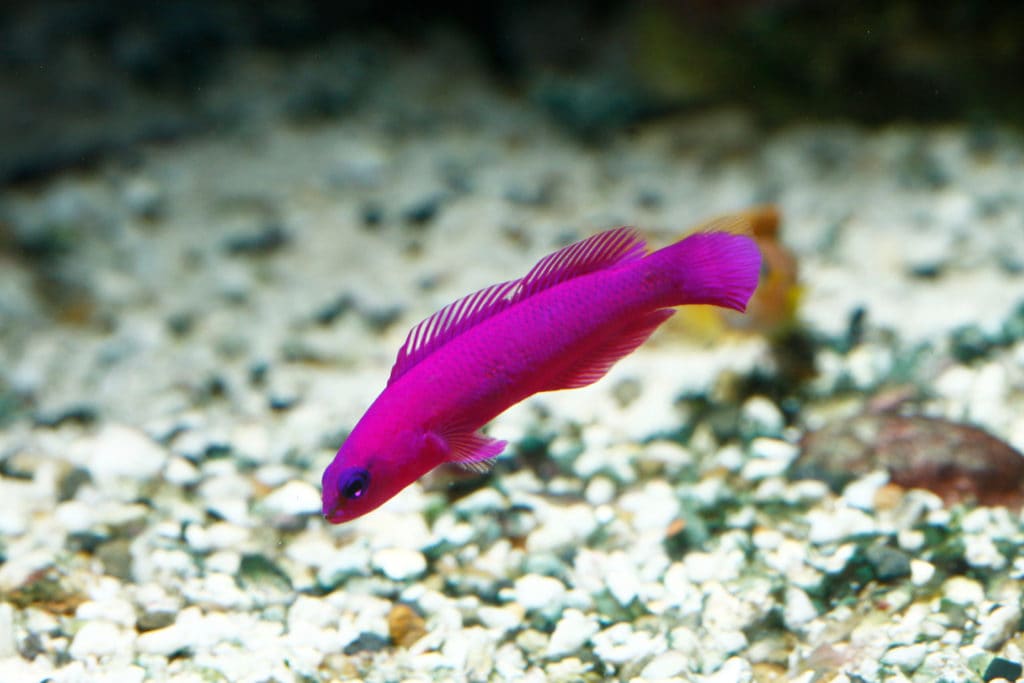
Photo: Pavaphon Supanantananont/Shutterstock
Dottybacks are all extremely lively fish, with personalities much bigger than their size suggests. Compared to the fairly large and notoriously scrappy splendid dottyback (P. splendens), orchids (which reach 3 inches as adults) almost seem docile, but make no mistake: They are not to be underestimated. Their personality varies notably depending on the species composition of a given system. If housed with small, nonaggressive tankmates, an orchid dottyback will undoubtedly become the boss of the tank, spending much of its time in open water, asserting its dominance and defending its cave with tenacity. If the other tank inhabitants consist of larger and more aggressive species, this dottyback will prefer to remain safely hidden in its cave, cautiously emerging at feeding time to grab a quick meal.
Dottybacks are plankton feeders in the wild; they respond well to a captive diet that mimics these preferences in the form of mysids, krill and brine shrimp, but they will quickly adapt to most dry or frozen foods offered. They are best kept singly or in mated pairs in tanks of 30 gallons or larger with plenty of hiding places.
Like clownfish, pseudochromids are sequential hermaphrodites, but the gender shift is reversed so that females can turn into males instead of the reciprocal outcome. This specific type of hermaphroditism is categorized as protogynous, literally meaning “first female,” as opposed to protandrous or “first male.” The expression of sexual dimorphism in dottybacks is opposite to clownfish, with male pseudochromids being the larger of the two fish in a mated pair. Despite these differences, the males are still the ones responsible for almost 100 percent of the parental care. Males attract females by performing mating dances near the entrances to their caves, enticing them to deposit masses of up to 1,000 sticky eggs. Males will guard and aerate these fertilized egg masses for three to six days before they hatch.
These feisty, brightly colored fish make great reef tank inhabitants, but they have been known to harass and/or eat ornamental invertebrates. If the crustacean was already established upon addition of the dottyback, the chances of the invertebrate meeting an unfortunate end are smaller than if introduced after the dottyback, but one cannot just expect them to coexist peacefully.
- Temp: 72 to 78 degrees
- pH: 8 to 8.4
- Water Hardness: dKH 8 to 12
- Size: 3 inches
- Food: Meaty foods with a focus on plankton
- Orientation: Middle
5. Maroon clownfish, spinecheek anemonefish (Premnas biaculeatus)
Considering how many CB clownfish species are now available, it seemed reasonable to feature more than one anemonefish on this list, especially when taking into account how vastly different the personality of this particular species is compared to that of ocellaris clowns. Maroons are big (can be 7 inches long as adults), aggressive, territorial and stubborn, and they always seem to have a different vision for aquascaping than do their aquarists. They are the only species in the genus Premnas and are primarily differentiated from all other clowns by the presence of a defined pair of long spines along their cheeks. The disparity in size between genders is extremely obvious, with a healthy male being at most half the size of his robust mate. Their coloration differs notably, with males typically having brilliant-red bodies and females being much darker and muddier in color. These characteristics seem to be far more pronounced in wild specimens than CB ones. Although two strains of maroons exist, yellow-striped and white-striped, they are still thought to belong to a single species, and the striping differences are attributed to geographical variation instead of genetic divergence.

Photo: iliuta goean/Shutterstock
As mentioned when discussing ocellaris clowns, these fish do not need host anemones to survive and thrive, but they are noticeably calmer when one is present. Their natural anemone host is the bubble tip (E. quadricolor), which is the most popular anemone choice in captivity, but they have been known to host in several species in controlled environments. In home aquaria, these bold fish will dominate almost any tank with their pugnacious nature, and they will regularly remind their human caretakers of how ferocious they are by posturing, charging and biting our well-meaning hands. They are hearty eaters and should be provided with plenty of meaty foods and an aquarium of no less than 40 gallons. While they do best when kept in established pairs, great caution should be exercised when attempting to pair them. This is accomplished most successfully by acquiring a large, mature female and a juvenile male and adding both fish to your aquarium at the same time. That said, there is always a chance this method will not work, at which point the clowns may need to be separated to avoid unnecessary harm to the smaller fish.
Despite their difficult demeanor, these beautiful fish can be a rewarding focal point of a home aquarium, and they are, thankfully, fairly easy to obtain now that the vast majority of them are CB instead of wild-caught. ORA recently released an incredible designer morph of this clownfish called the Gold Nugget Maroon that is truly a wonder to see. Even if designer clowns do not pique your interest as a hobbyist, they are worth a look if for no other reason than to be aesthetically wowed.
- Temp: 72 to 78 degrees Fahrenheit
- pH: 8 to 8.4
- Water Hardness: dKH 8 to 12
- Size: 6 to 7 inches (mature female)
- Food: Variety of meaty foods (Mine preferred shrimp more than anything else.)
- Orientation: Primarily middle, but they will travel all over their aquarium to assert dominance.
6. Yellow assessor, gold assessor basslet, yellow devilfish (Assessor flavissimus)
Oceans Reefs and Aquariums (ORA) were the first to produce these aquacultured fish and continue to be the primary source for them. Assessors may resemble dottybacks, but they have a different temperament and are less territorial. While pseudochromids may actively hunt for invertebrates, assessors typically wait for food to pass by the same way they would behave as zooplankton specialists in nature. They also look similar to some of the basslets but are classified in the Plesiopidae family along with the marine betta or comet. Like basslets, assessors tend to orient themselves upside down so that their ventral surface runs parallel to the roof of their cave or overhang. This peculiar swimming style dictates that we should provide similar structures for them when maintaining these fish in captivity. 
These 3-inch-long, attractive, hardy fish are native to western Pacific waters ranging from Australia to Papua New Guinea. They make great additions to a reef tank of 20 gallons or larger. Until recently, these fish were almost exclusively available as wild-caught specimens and were not imported too frequently, making them expensive for their diminutive size. But they are now bred in captivity and are consequently much more affordable. There are no easily discernible differences between males and females, but males seem to do the majority of the egg tending, and the females guard the area around their nest. While some assessor species such as the blue assessor (A. macneilli) are mouth brooders, the yellow devilfish (A. flavissimus) is a nest spawner, making it a good candidate for large-scale captive breeding.
Yellow assessors are generally known to be docile fish, but they can become quite aggressive with conspecifics. As a result of their propensity for fighting with members of their own species, it is advised when housing them in smaller tanks to keep only one. If maintaining multiples of them, provide plenty of space and ample hiding places. They are not picky eaters; they will typically adapt to a wide range of prepared foods but seem to prefer smaller particle sizes that more closely resemble their wild diet of zooplankton. They are extremely shy fish when added to an aquarium and spend much of their time in hiding, but after a few weeks, they will readily venture outside of their safe zone and periodically traverse the water column.
- Temp: 72 to 78 degrees
- pH: 8 to 8.4
- Water Hardness: dKH 8 to 12
- Size: 3 inches
- Food: Variety of small, meaty foods
- Orientation: Middle
7. Common seahorse, estuary seahorse, yellow seahorse (Hippocampus kuda)
One of the most encouraging successes in captive breeding has been the seahorse. These fragile animals travel poorly, and wild-caught seahorses have high mortality rates due to shipping stress. They are difficult animals to feed, as they typically require live foods and don’t readily adapt to frozen options. They are also susceptible to a variety of diseases that are nearly impossible to treat because of their delicate nature.
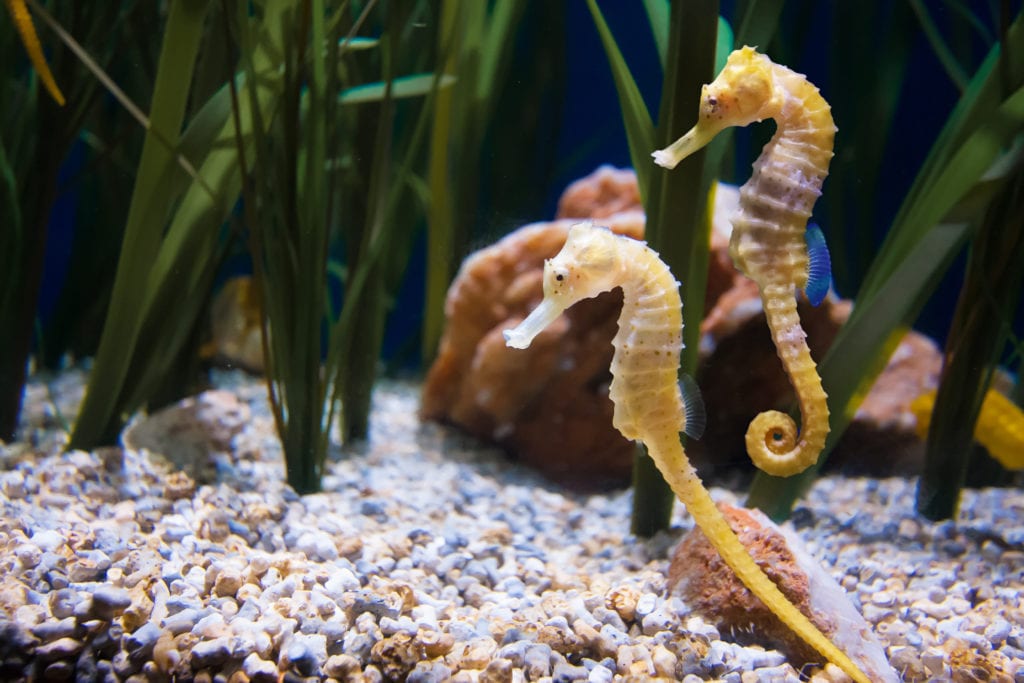
Photo: Studio 37/Shutterstock
The genus Hippocampus was listed on Appendix II by CITES in 2004, a designation that drastically restricted the number of animals that could be legally collected. After a decade of protection, many populations have rebounded significantly. At least three species of tank-bred seahorses are now regularly available in the hobby—H. kuda, H. reidi and H. erectus—and it is rare to see wild-caught seahorses for sale anymore. It used to be that many wild-caught seahorses would perish when kept in aquariums because they couldn’t be trained to eat prepared foods; it is time-consuming and unrealistic for the average hobbyist to raise live foods that must be fed out multiple times daily, so seahorses would often be malnourished and slowly starve to death. Thankfully, this doesn’t happen much anymore because CB seahorses are trained to accept frozen foods as juveniles. By the time they are sold to aquarists, they are completely weaned off live foods and will readily consume thawed mysis, brine and pacific plankton (Euphausia). Achieving proper nutrition was one of the greatest obstacles in seahorse husbandry, and it was overcome through captive breeding.
It is not particularly difficult to entice seahorses to spawn, but the tiny juveniles are challenging to rear due to their need for extremely high food densities to induce a healthy feeding response. Adult males have large, visible brood pouches where they incubate fertilized eggs for two to fours weeks before the juveniles are born live. Hippocampus kuda, and essentially all CB seahorses, do best when kept in species tanks. They don’t fare well in community systems because of their peaceful and docile nature. They will be easily outcompeted for food by even the most non-aggressive tankmates as a result of their slow speed and awkward maneuverability. House them with other seahorses and potentially pipefish, which have similar eating habits. Multiple daily feedings are recommended. Seahorses have prehensile tails, and as such, they need structures in their habitats onto which they can attach their tails for stability. Real or fake gorgonians, branching corals, sea grasses or aquarium ornaments of similar shape all make for good hitches and are necessary in order to make them comfortable. Bright lighting is preferable, as well as a sweeping current that will keep uneaten food from settling and decaying in the aquarium.
- Temp: 72 to 78 degrees
- pH: 8 to 8.4
- Water Hardness: dKH 8 to 12
- Size: 11 inches (with tail extended)
- Food: Meaty foods; preference for mysis, pacific plankton and brine
- Orientation: Entire tank, depending on the tank’s depth and anchor points
8. Fang blennies or saber-toothed blennies (Meiacanthus spp.)
These reef-compatible, generally agreeable and attractive fish are finally increasing in popularity and availability in the world of CB ornamentals. Eight species of Meiacanthus have been successfully bred in a captive environment, but most are still available only sporadically. The canary blenny (M. oualanensis) is probably the easiest CB fang blenny to find for sale. These ideal reef fish provide us with the opportunity to support the CB side of our hobby by preferentially buying individuals that have been spawned and reared in captivity as opposed to those that have been wild-caught. While wild fang blenny populations are not being threatened by collection pressure, it is still important for us as conscientious aquarists to “vote with our wallets” and show the CB industry that we’re ready for this shift to sustainable reefkeeping. 
Fang blennies are versatile reef fish that are both docile and defensive. They are peaceful and non-combative with other fish of similar temperament but capable of holding their own against aggressors. They have an elongated body type with a single dorsal fin that runs almost the entire length of their slender bodies and exhibit a wide variety of colors and patterns. Fang blennies, and blennies in general, are inquisitive by nature and always seem to be interested in knowing what’s going on around them. Fish in this genus, of which there are almost 30 species, are distributed throughout the western Pacific and Indian Oceans and typically inhabit shallow reef ecosystems, but there are exceptions, with M. erdmanni having recently been discovered at depths exceeding 200 feet.
They get their common name from the presence of an enlarged pair of venomous canine teeth. As planktivores, fang blennies don’t use their venom to kill these small prey items but employ their use almost exclusively when defending themselves or their territories. This defense mechanism is so effective that some fish species (e.g. Ecsenius bicolor) mimic a fang blenny’s appearance by having evolved coloration patterns around their mouths that resemble these fangs to deter predators.
Fang blennies will breed fairly readily in captivity. It has been documented that while they will form mated pairs, they are more prolific when maintained in harems. They exhibit no apparent sexual dimorphism, so it is extremely difficult to form pairs in captivity. This is done most easily by introducing multiple individuals at once and allowing them to form harems on their own, subsequently removing any subordinate males to prevent them from being harassed by the dominant male. Males are responsible for most egg-tending responsibilities and are known to care for eggs from more than one female at once in a single nest. Eggs hatch in about eight days.
Fang blennies are great for all aquarists, from beginner to veteran, and will add welcomed color, liveliness and personality to almost any system of 20 gallons or larger.
- Temp: 72 to 78 degrees
- pH: 8 to 8.4</
Share:
